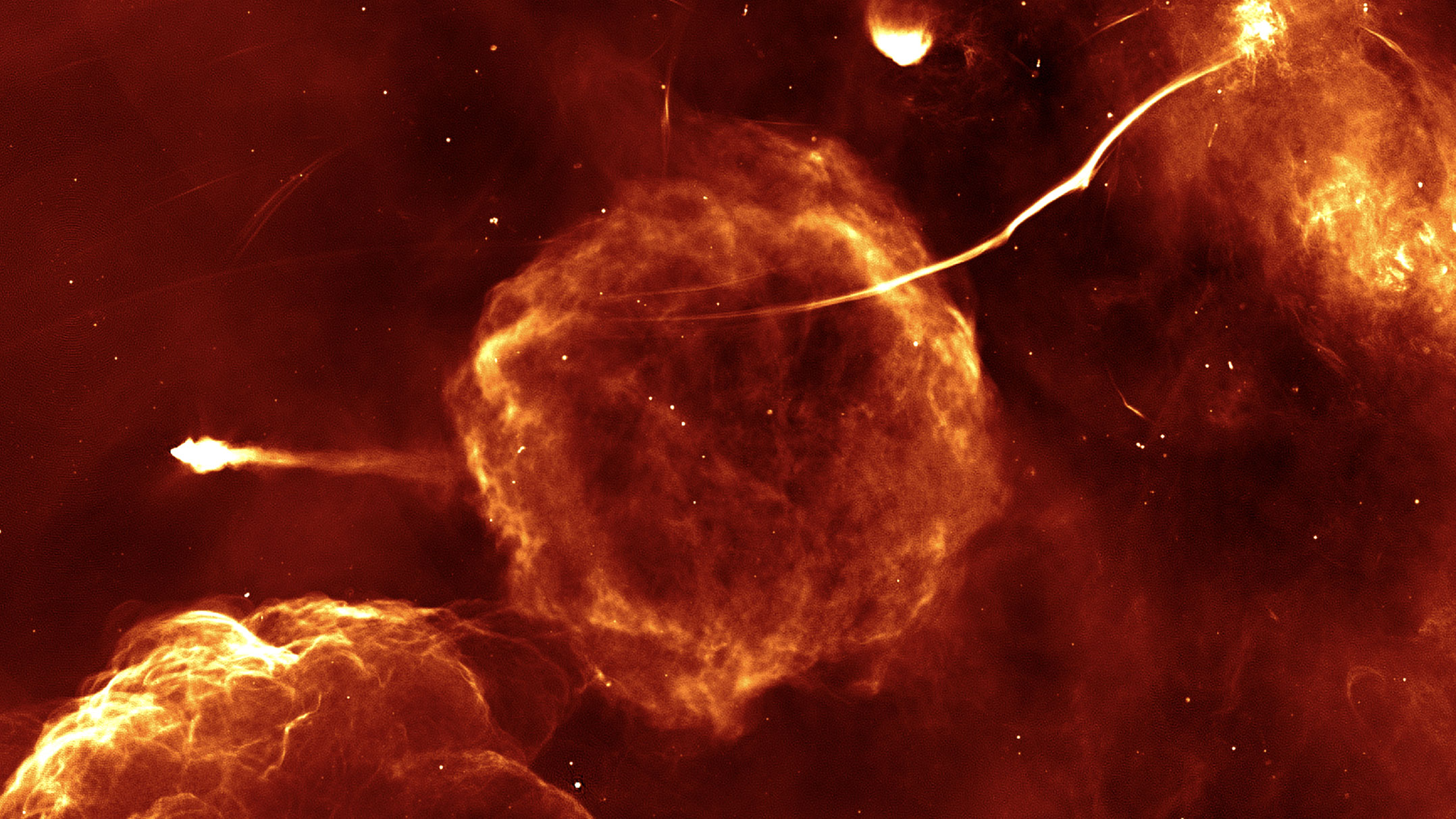South Africa’s MeerKAT radio telescope, discovered a mysterious ring of light in space, marking a significant breakthrough in cosmic exploration.
South Africa’s MeerKAT telescope unveils a unique discovery, in a major leap for space discovery in Africa

A rare cosmic discovery from South Africa’s MeerKAT telescope has marked a major milestone in space research. It underscores the continent’s expanding influence in the global space industry as more African nations invest in homegrown satellites and diversify their use of space technology.
Bonface Orucho, bird story agency
Astronomers using South Africa’s MeerKAT radio telescope, a precursor to Africa’s Square Kilometer Array (SKA) project, dubbed the world’s largest telescope network, have discovered a mysterious ring of light in space, marking a significant breakthrough in cosmic exploration.
“We present the serendipitous discovery of a new radio-continuum ring-like object nicknamed Kýklos (J1802–3353), with MeerKAT UHF and L-band observations,” the researchers wrote in a research paper in the Astronomy & Astrophysics journal.
According to space.com, the ring emits radio waves and has been labelled ‘Kýklos’. It falls into the class of ‘Odd Radio Circles’—unique rings of light in space that are invisible at any other wavelength and whose origin remains a mystery.
The researchers report that Kýklos is only seen at radio wavelengths, where it is faint, patchy, thin (just 6 arcseconds thick) and forms almost a perfect circle.
A team of astrophysicists from the Catania Observatory in Italy made the discovery in 2022. They identified and catalogued the unique object as ORC J1054–4602.
According to Cristobal Bordiu, the lead astrophysicist for the discovery, “the morphological and spectral characteristics of Kýklos appear more consistent with those of a Wolf-Rayet shell.”
Wolf-Rayet is a rare and massive type of star that is in a late stage of evolution.
According to physis.org, Wolf-Rayets are known for their intense radiation and are often associated with nebulae formed by the material they have expelled.
The first ORCs were noticed in 2019 by astronomers surveying space using the Australian Square Kilometer Array Pathfinder telescope, or ASKAP.
Like MeerKAT, ASKAP is a precursor to the Square Kilometer Array (SKA), a telescope initiative comprising two giant telescopes created from more than 130000 antennas and 200 satellite dishes.
Construction works on two sites, one in South Africa and one in Australia, began in 2022 with projections showing the project could be complete by 2028, potentially enabling astronomers to study space better and faster.
While Kýklos is not the first ORC discovered, it stands out as the first one found above the plane of Earth’s galaxy, positioned roughly six degrees above us. It also appears to be near the galactic centre, though scientists believe it could be either much closer or much farther away than the centre of our galaxy, which is 26,000 light-years distant.
Notably, prior ORC discoveries have all been found at high galactic latitudes. They are therefore positioned high above the plane of the Milky Way galaxy, meaning that they are either very close to us within our galaxy or they are extragalactic.
The discovery of Kýklos using South Africa’s MeerKAT telescope underscores the project’s potential while also showcasing the continent’s potential to lead groundbreaking research and unlock more discoveries in space.
According to the project’s scientists, the SKA-Mid in South Africa will operate with four times the resolution and five times the sensitivity, therefore allowing surveying of the sky 60 times faster than existing telescopes.
Beyond South Africa, eight African countries, including Botswana, Ghana, Kenya, Madagascar, Mauritius, Mozambique, Namibia and Zambia, will also host radio telescopes that will contribute to the parent advanced radio space array.
The discovery of Kýklos comes at a pivotal moment when many African countries are increasingly investing in space technology, with around 60 satellites currently in orbit from about 20 countries. Notably, recent satellites are made in Africa, marking a significant shift from past satellite ventures and highlighting the continent’s growing role in the global space industry.
Morocco has for instance, in the past week launched the country’s first Morocco-made nanosatellites for earth observation and radio communication. The two are creations by joint teams from Mohammed V University in Rabat, the National Centre for Scientific & Technical Research and the Royal Centre for Space Studies and Research.
Senegal also launched its first-ever satellite into space on August 16. Senegalese engineers built GAINDESAT-1A in partnership with those from the ‘Centre Spatiale Universitaire de Montpellier’ (CSUM).
Enhanced access to space is expected to boost Earth observation capabilities, thereby supporting crucial sectors such as agriculture, climate planning, and more.
The benefits of increased space access extend beyond traditional sectors, reaching into areas like tourism. For example, South Africa’s Department of Tourism, in collaboration with the Department of Science and Innovation (DSI), is preparing to unveil the country’s astro-tourism strategy.
The launch is scheduled for September 27 during National Tourism Day celebrations in the Northern Cape at the MeerKAT project precincts. This initiative could position South Africa as the first African nation to develop a National Astro-Tourism Strategy, aiming to establish the country as a premier global destination for astro-tourism.
According to Space in Africa, Africa’s space industry is projected to grow to US$23 billion by 2026, up from US$20 billion in 2021. In fact, a 2021 report by the World Economic Forum estimates that improved Earth observation data could unlock over US$2 billion in value for Africa.





